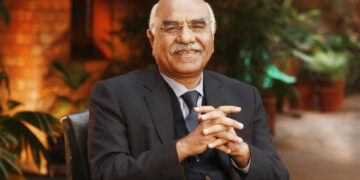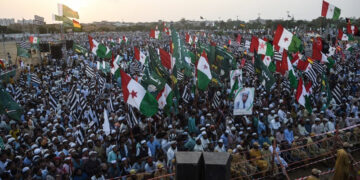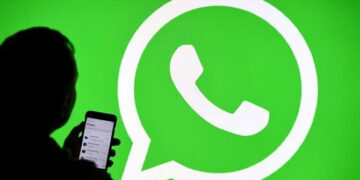 Photos and videos of Al Qaeda founder Osama bin Laden after he was killed in May in a U.S. military/Central Intelligence Agency raid in Pakistan should not be released publicly because they would reveal military and intelligence secrets and could lead to violence against U.S. personnel, the Obama administration argued in papers filed in federal court in Washington late Monday night.
Photos and videos of Al Qaeda founder Osama bin Laden after he was killed in May in a U.S. military/Central Intelligence Agency raid in Pakistan should not be released publicly because they would reveal military and intelligence secrets and could lead to violence against U.S. personnel, the Obama administration argued in papers filed in federal court in Washington late Monday night.
The new filings from the Justice Department provide scant details about the imagery, but CIA National Clandestine Service Director John Bennett wrote that the CIA has “52 unique….photographs and/or videorecordings” depicting bin Laden during or after the May operation. Bennett did not break down the tally further, but said all the imagery is classified “TOP SECRET,” meaning that disclosure of the material could lead to “exceptionally grave damage” to U.S. national security.
“All of the responsive records are the product of a highly sensitive, overseas operation that was conducted under the direction of the CIA,” Bennett wrote, arguing that disclosure of the information would reveal “intelligence activities and/or methods.” He called the photos “gruesome,” and said they depict the gunshot wound to bin Laden’s head. It is unclear whether his descriptions referred to all the images and videos, or just some of them.
The motion for summary judgment and supporting declarations ask U.S. District Court Judge James Boasberg to rule for the government in a Freedom of Information Act lawsuit brought in May by Judicial Watch. The conservative watchdog group sued the Defense Department after it failed to comply with the group’s request for the bin Laden imagery. The suit was broadened in June to name the CIA as a defendant.
While the Justice Department’s motion is backed by declarations from high ranking officials at the Pentagon and CIA, the government lawyers make clear that their marching orders come from the top. Near its outset, the brief quotes President Barack Obama’s comments on the issue during a “60 Minutes” interview in May.”It is important for us to make sure that very graphic photos of somebody who was shot in the head are not floating around as an incitement to additional violence. As a propaganda tool. You know, that’s not who we are. You know, we don’t trot out this stuff as trophies,” Obama said. “We don’t need to spike the football.”
The brief includes Obama’s claim that then-Defense Secretary Robert Gates, Secretary of State Hillary Clinton and intelligence officials “all” agreed that releasing the images would “create some national security risk.” The legal papers do not mention that before Obama made the decision to keep the images secret, then-CIA director Leon Panetta said there was no “question that ultimately a photograph would be presented to the public.” (Panetta has since become defense secretary.)
The government’s filings Monday were also accompanied by a declaration from Admiral William McRaven, who heads the U.S. Special Operations Command and commands the Navy SEALs who carried out the bin Laden raid. McRaven argues that release of the imagery “could reasonably be expected to…make the special operations unit that participated in this operation and its members more readily identifiable in the future.” Portions of McRaven’s arguments were classified and filed under seal.
In another declaration, the head of operations for the military’s joint staff, Lt. Gen. Robert Neller, argued that release of the bin Laden death imagery could lead to violence against U.S. military personnel in Afghanistan, Afghan civilians and police, Afghans working with the U.S., and U.S. citizens worldwide. Neller also said releasing the images could “aid the recruitment efforts…of insurgent elements” in Afghanistan, “weaken the new Democratic government of Afghanistan, and add extremist pressures on several of our regional allies.”
The legal fight over the bin Laden photos has produced some disagreement among FOIA experts. Some expect the government to prevail in the case without much difficulty because courts are traditionally very deferential to the executive branch in litigation involving national security, particularly FOIA cases. However, a few FOIA specialists have said aspects of the government’s arguments against disclosure is weaker than in other cases, chiefly because of reliance on the harms that stem in essence from the public relations impact the imagery could have.
Judicial Watch was not the only organization to request the photos and video. Several news organizations, including the Associated Press and POLITICO, also did so.The government’s new filings appear to offer some openings for attack on the part of those pressing for disclosure.First, while the arguments for withholding imagery from the raid and its immediate aftermath are legally strong, those for withholding the images of bin Laden’s burial seem substantially weaker.
It’s hard to see how that event implicates any national security secrets. Second, the CIA’s claim that none of the images or videos can be released even in part seems conclusory. A heavily-edited video of bin Laden’s burial, for example, might or might not not be very interesting, but for that same reason it seems less likely to produce the negative consequences the government warns about.
The government filings claim that the Defense Department found no imagery responsive to the requests. Sources previously told POLITICO that at least some of the images were on a secure, classified interagency network accessible to individuals at various agencies. The new court filings don’t make clear who took the photos and video. If they were in posession of military personnel at the time the FOIA requests were made or thereafter, some of the arguments for disclosure could be strengthened.
However, it’s also possible that the courts may accept that the entire operation is an intelligence activity that the CIA is entitled to keep secret or disclose as it sees fit.Judicial Watch is scheduled to respond to the government’s filings by October 24. Boasberg, an Obama appointee confirmed to the district court in March of this year, is unlikely to rule before December. – Politico












